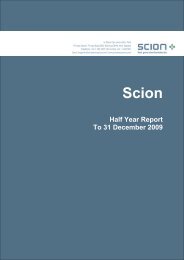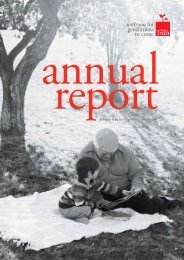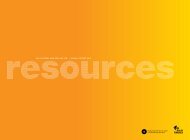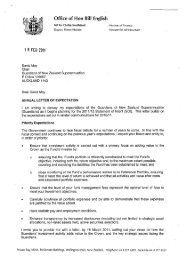apr-11.pdf (2.07 MB) - Crown Ownership Monitoring Unit
apr-11.pdf (2.07 MB) - Crown Ownership Monitoring Unit
apr-11.pdf (2.07 MB) - Crown Ownership Monitoring Unit
You also want an ePaper? Increase the reach of your titles
YUMPU automatically turns print PDFs into web optimized ePapers that Google loves.
...and invest in different levels of growth assets to helpmeet their respective objectivesEach entity is responsible for determining its own investment strategy.In general, the higher the allocation to growth assets (eg, listedequities, property, commodities, unlisted/private equity) the morerisky/volatile the returns on the investment portfolio are expected to be.Typically there is less correlation between growth assets (especiallyequities) and the value of future liabilities than there is between incomeassets and the value of future liabilities (in particular duration matched,and, where applicable, inflation-linked bonds). As such, the volatilityof the funding ratio (assets over liabilities) is likely to be higher wherethere is a significant allocation to growth assets. However, wherethere is a funding gap, an allocation to growth assets can help bridgethis gap by delivering an expected return premium over time. Indetermining the growth/income asset mix of the investment portfolios,each CFI gives consideration to the following factors:• the relevant legislation, including ministerial directives• the return objective(s) of the fund – typically stated in relation tocash or Government bond indices• the CFI’s investment horizon – generally the longer the investmenttime horizon the more short-term volatility can be tolerated• the current level of unfunded outstanding claims liability (whereapplicable) – typically the higher the funding level (assets overliabilities) the higher the level of income assets• the timing, or duration, of the future liabilities – the longer theduration of the liabilities the more sensitive they are to changesin interest rates and inflation• liquidity requirements – where short-term cash flows are required,or may be required at short notice, a high level of liquid investments is desirable, and• the level of current and expected future contributions.The current investment strategies employed by each of the CFIs are summarised in thefollowing table.Table 9 – Growth/income mix across CFI portfolioCase study – GSFThe past service liabilities for membersof the GSF Scheme are clearly definedand the scheme is mature (annuitantsoutnumber contributors by about four toone). This normally would suggest that themajority of assets of the Fund should beinvested in relatively low-risk fixed interestinvestments, but the large unfunded liabilitygives rise to GSF employing a much moregrowth-oriented investment portfolio.The scale of the unfunded liability andthe estimated lifetime of the liabilities ofthe scheme (up to 60 years) means thatthe Fund can tolerate more short-termvolatility (in an attempt to partially closethe funding gap) without significantlyimpacting on the short-term fundingrequirements from the Government(currently about $700 million per annum).Contributions to the schemes in relationto active members are already insufficientto fund annual benefit payments. Theschemes within GSF have been closedto new members since 1992. While theliabilities of the Fund are substantial,these are expected to reduce over time asthe scheme continues to mature.CFI Growth (%) Income (%) Influencing FactorsACC 35 65 • High level of funding in some accounts• Mix of short- and long-term liabilities• Target full funding by 2018/19GSF 70 30NZSF 80 20EQC 30 70NPF 25 75• See case study opposite• Long investment horizon; no withdrawals until2030/31• No recognised liabilities• Legislated to “maximise return without undue risk”• Unpredictable future liabilities• Short-term liquidity requirements• Average asset weighted benchmark of 11 schemespage | 45
















